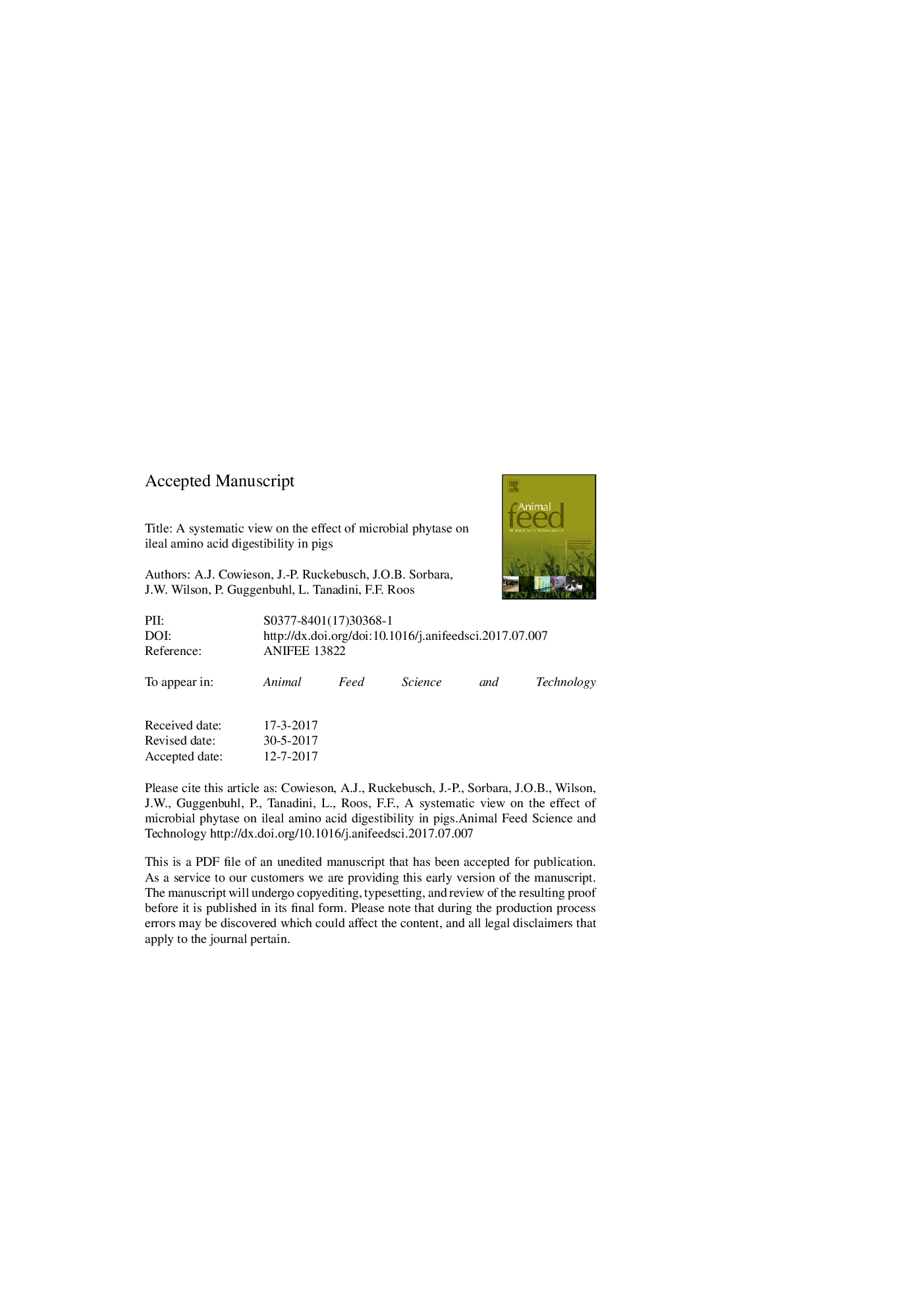| کد مقاله | کد نشریه | سال انتشار | مقاله انگلیسی | نسخه تمام متن |
|---|---|---|---|---|
| 5538810 | 1552355 | 2017 | 28 صفحه PDF | دانلود رایگان |
عنوان انگلیسی مقاله ISI
A systematic view on the effect of microbial phytase on ileal amino acid digestibility in pigs
ترجمه فارسی عنوان
دیدگاه سیستماتیک در مورد اثر فیتاز میکروبی بر قابلیت هضم اسید آمینه اسید منی در خوک ها
دانلود مقاله + سفارش ترجمه
دانلود مقاله ISI انگلیسی
رایگان برای ایرانیان
موضوعات مرتبط
علوم زیستی و بیوفناوری
علوم کشاورزی و بیولوژیک
علوم دامی و جانورشناسی
چکیده انگلیسی
Data on the effect of microbial phytase on apparent ileal amino acid digestibility coefficients in pigs were transcribed from a total of 28 peer-reviewed papers in order to determine response patterns and overall effects. Transcribing the digestibility responses from the various papers resulted in a database with 925 observations from diets that were principally based on corn, soybean meal, canola meal and various co-products such as ricebran, wheatbran and distillers dried grains and solubles (DDGS). The majority of experiments utilized grower pigs of approximately 30 kg live-weight fitted with ileal cannulas but pigs from 6 to 71 kg in weight were represented as well as studies using post-mortem digesta collection techniques. Most papers were published between 2005 and 2016 but several were published prior to these dates. Phytase doses represented ranged from 250 FYT/kg to 20,000 FYT/kg feed though most observations ranged between 500 and 1000 FYT/kg. The overall effect of microbial phytase inclusion on apparent ileal amino acid digestibility coefficients was +2.8% and this ranged from +0.9% for Met to +4.1% for Pro. Above average responses were noted for Pro > Thr > Gly > Trp > Glu > Ala > Asp and Phe with particularly modest responses for Met, Arg and Cys. Phytase effects on apparent ileal amino acid digestibility coefficients were greater in diets with lower inherent amino acid digestibility. Increasing phytase dose from 250 to 2000 FYT/kg had no significant influence on phytase effect on amino acid digestibility although extending this dose range to 20,000 FYT/kg resulted in a moderate increase in mean response. Pig weight at time of digesta collection had no significant effect on overall phytase efficacy. There was a significant but weak correlation between ileal phosphorus and amino acid digestibility responses to phytase. It may be concluded from the meta-analysis presented herein that phytase can significantly increase apparent ileal amino acid digestibility in pigs at various weights (at least from 6 to 70 kg). The pattern of response by amino acid is different from broilers and therefore a common amino acid matrix for both chickens and pigs is inappropriate. Furthermore, it may be that phytate, while remaining a poorly available source of P (and a potential source of myo-inositol), may not represent as potent an antinutrient (on the protein/amino acid axis) in swine as it does in broilers. Thus, the beneficial effects of phytase on amino acid digestibility in swine may originate more from increased dietary protein digestibility and less from meaningful changes in endogenous amino acid flow, an observation that has implications for the additivity of amino acid matrix values of different enzymes in both species. The present review suggests that different phytases with equivalent effects on phosphorus digestibility should have equivalent amino acid release values assigned and that species-dependent values are not only justified but of critical importance to optimal use of phytase in animal production.
ناشر
Database: Elsevier - ScienceDirect (ساینس دایرکت)
Journal: Animal Feed Science and Technology - Volume 231, September 2017, Pages 138-149
Journal: Animal Feed Science and Technology - Volume 231, September 2017, Pages 138-149
نویسندگان
A.J. Cowieson, J.-P. Ruckebusch, J.O.B. Sorbara, J.W. Wilson, P. Guggenbuhl, L. Tanadini, F.F. Roos,
